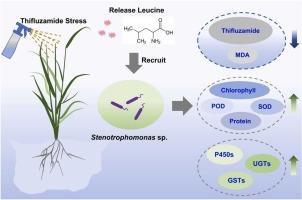水稻层球细菌介导对农药胁迫的有益反应
IF 11.3
1区 环境科学与生态学
Q1 ENGINEERING, ENVIRONMENTAL
引用次数: 0
摘要
农药对农业生产力至关重要;然而,由于其持久性和非目标效应,对生态系统和人类健康构成重大风险。本研究探讨了根球细菌窄养单胞菌在减轻农药胁迫和提高植物抗逆性中的作用。本研究利用广泛使用的杀菌剂硫氟唑胺(thfluzamide, TF)研究了水稻层际微生物群对农药暴露的适应性反应。高通量测序显示,TF显著降低了微生物群落的丰富度,同时丰富了特定的细菌属,如窄养单胞菌、Pantoea和鞘氨单胞菌。代谢组学分析表明,TF增加了亮氨酸等氨基酸,促进了窄养单胞菌St10的募集和生长。该菌株对霉霉具有较高的抗性,并在离体和植株内有效降解霉霉,降低了霉霉在水稻组织中的残留水平。此外,窄养单胞菌St10通过提高叶绿素含量、降低丙二醛水平和提高抗氧化酶活性来缓解tf诱导的水稻生理应激。转录组学分析显示,St10寡食单胞菌激活了水稻中与农药脱毒相关的基因,包括细胞色素p450、谷胱甘肽转移酶和udp -糖基转移酶。这些发现强调了窄养单胞菌St10在直接降解TF和增强寄主植物解毒机制方面的双重作用。本研究为研究层层微生物与寄主植物在农药胁迫下的相互作用提供了新的思路。本文章由计算机程序翻译,如有差异,请以英文原文为准。

Rice phyllosphere bacteria mediates beneficial responses to pesticide stress
Pesticides are essential for agricultural productivity; however, pose significant risks to ecosystems and human health due to their persistence and non-target effects. This study investigates the role of phyllosphere bacteria Stenotrophomonas sp., in mitigating pesticide stress and enhancing plant resilience. We explored the adaptive responses of the rice phyllosphere microbiome to pesticide exposure using thifluzamide (TF), a widely used fungicide. High-throughput sequencing revealed that TF significantly reducing microbial communities’ richness while enriching specific bacterial genera such as Stenotrophomonas, Pantoea, and Sphingomonas. Metabolomic analysis indicated that TF increasing amino acids like leucine, which facilitated the recruitment and growth of Stenotrophomonas St10. This strain demonstrated high resistance to TF and effectively degraded the fungicide in vitro and in plant, reducing residual TF levels in rice tissues. Additionally, Stenotrophomonas St10 alleviated TF-induced physiological stress in rice by enhancing chlorophyll content, reducing malondialdehyde levels, and increasing antioxidant enzyme activities. Transcriptomic analysis revealed that Stenotrophomonas St10 activated pesticide detoxification-related genes in rice, including cytochrome P450s, glutathione transferases, and UDP-glycosyltransferases. These findings highlight the dual role of Stenotrophomonas St10 in directly degrading TF and enhancing host plant detoxification mechanisms. This study provides novel insights into the interactions between phyllosphere microbes and host plants under pesticide stress.
求助全文
通过发布文献求助,成功后即可免费获取论文全文。
去求助
来源期刊

Journal of Hazardous Materials
工程技术-工程:环境
CiteScore
25.40
自引率
5.90%
发文量
3059
审稿时长
58 days
期刊介绍:
The Journal of Hazardous Materials serves as a global platform for promoting cutting-edge research in the field of Environmental Science and Engineering. Our publication features a wide range of articles, including full-length research papers, review articles, and perspectives, with the aim of enhancing our understanding of the dangers and risks associated with various materials concerning public health and the environment. It is important to note that the term "environmental contaminants" refers specifically to substances that pose hazardous effects through contamination, while excluding those that do not have such impacts on the environment or human health. Moreover, we emphasize the distinction between wastes and hazardous materials in order to provide further clarity on the scope of the journal. We have a keen interest in exploring specific compounds and microbial agents that have adverse effects on the environment.
 求助内容:
求助内容: 应助结果提醒方式:
应助结果提醒方式:


